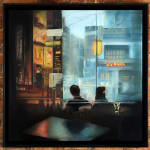Ewan Story
50 x 50 cms
Further images
Rückenfiguren captures a precise emotional truth of our era: the illusion of closeness amidst pervasive disconnection. It is a study in thresholds – between people, places, inner states – and a timeless reminder of our longing for connection.
The work presents a quiet yet disquieting meditation on modern alienation and emotional detachment within urban life.
Drawing inspiration from the German Romantic tradition, particularly the visual device pioneered by Caspar David Friedrich, the painting places two anonymous figures in the foreground, backs turned to the viewer. This compositional strategy displaces individual identity, inviting us to step into their place and project our own emotional narratives onto the scene.
The two central figures are seated side-by-side in what appears to be a café or bar: an intimate, communal setting made emotionally vacant by their silent disconnection. They are physically proximate, yet profoundly separate.
The woman, turned slightly away, wears earphones: subtle yet powerful symbols of self-imposed detachment in our hyper-connected age. The presence of these may go unnoticed by the man beside her – and perhaps even by the viewer on first glance – heightening the poignancy of potential intimacy obstructed by invisible barriers.
The palette of Rückenfiguren is as psychologically nuanced as its subject. The left side of the canvas glows with warm amber tones of the interior, filled with inscrutable décor and signage, evoking a sense of the familiar rendered foreign. The right side, visible through the large glass window, is bathed in sterile, frigid blues: the chromatic coolness of the city beyond. Between these two worlds lies a pane of glass that reflects and refracts, both separating and connecting the figures and their environment.
The table in the foreground is a crucial compositional element, bridging both the warm and cold halves of the canvas. It is smooth, reflective, and largely empty, save for an abandoned glass and a cup and saucer: subtle signifiers of transience and absence. This threshold object links interior and exterior, past and future, memory and anticipation. It anchors the viewer in the liminal space between observation and participation.
Perhaps most poignant is the quiet psychological resonance above the man’s head, where faint motes drift in an upward curl. Caught in a shaft of ambient light, they imply introspection, daydream, or even escape – the intangible matter of thought made momentarily visible.
Outside, the cityscape dissolves into an unreal confusion of forms: signage and architecture bleed into abstraction, mirroring the inner haze of the figures within.
- X
- Tumblr







